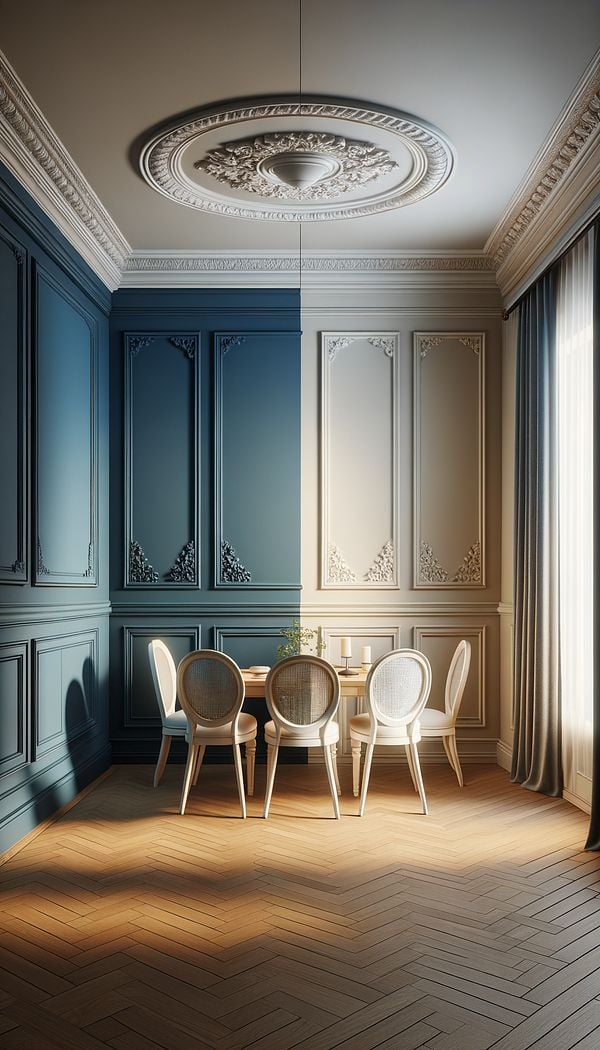What is Chair Rail?
Chair rail is a type of molding fixed horizontally to the wall around the perimeter of a room.
Description
Chair rail, also known as dado rail, is primarily a decorative architectural feature that also serves a practical purpose. Traditionally, it was installed in dining rooms to protect the walls from being scuffed or damaged by the backs of chairs. Positioned horizontally, its placement on the wall is typically one-third the height of the room from the floor, though this can vary based on design preferences and the room's architecture.
In modern interior design, chair rail offers a stylistic division of wall space, allowing designers to play with two-toned color schemes, textures, or even different types of wall treatments above and below the rail. This can create a striking visual contrast and add depth and character to a room. Furthermore, when used thoughtfully, chair rail can help to enhance the perceived proportions of a space, making rooms feel taller or cozier depending on the application.
Aside from its aesthetic value, the protective function of chair rail remains relevant in spaces where furniture movement is frequent, safeguarding plaster or drywall from potential impacts. It can be found in a variety of materials including wood, MDF (Medium Density Fibreboard), and plaster, and comes in an array of designs from simple to ornate, capable of complementing a wide range of decorating principles and elements.
Usage
Chair rail is commonly found in dining rooms, living rooms, hallways, and sometimes in bedrooms. It is incorporated not only for its original protective purpose but also to enhance interior design elements by dividing wall space for decorative treatments or contrasting paint colors. In historical homes or buildings, chair rail can also serve as a distinguishing architectural feature indicative of a specific era or design style.
FAQs
-
How high should chair rail be installed?
Chair rail is typically installed one-third the height of the room from the floor, around 32 to 36 inches. However, variations can occur based on design preference and room architecture.
-
Can chair rail be installed in rooms without chairs?
Yes, while traditionally used in dining rooms, chair rail is also used in other spaces for its aesthetic value, such as in living rooms, hallways, and bedrooms.
-
Does chair rail have to match the trim?
No, chair rail does not have to match the trim; however, coordinating the chair rail with the room’s other trim can create a cohesive look. Contrasting colors or styles can also be used to make a bold design statement.
Practical Application
When incorporating chair rail into your design, consider the overall aesthetic of your room. For a unified look, match the chair rail with existing trim or molding in your space. Alternatively, for a more dramatic effect, contrast the chair rail with the wall color or texture below it. Use the division created by the chair rail to experiment with two-toned walls or different wall treatments, such as wallpaper and paint. When installing, ensure the height and style of the chair rail complement the proportions and design theme of your room.
-
Architectural Elements199 articles
-
Design Styles478 articles
-
Decorative Techniques322 articles
-
Wall Treatments & Finishes157 articles
-
Shield BackA shield back is a specific design of chair back that resembles the shape of a shield.
-
BackingBacking refers to the material or support layer behind the visible layer of a product.
-
Mother of PearlMother of Pearl is the iridescent inner shell layer of certain mollusks.
-
ClusterCluster refers to a group of objects or elements intentionally placed together to form a cohesive arrangement.
-
French RenaissanceFrench Renaissance refers to a period of rebirth in French art and architecture, emulating classical forms with a focus on symmetry and proportion.
